 Petzlover
PetzloverAlaskan Malamute is originated from United States but Nebolish Mastiff is originated from Canada. Alaskan Malamute may grow 28 cm / 12 inches higher than Nebolish Mastiff. Alaskan Malamute may weigh 161 kg / 354 pounds lesser than Nebolish Mastiff. Both Alaskan Malamute and Nebolish Mastiff has almost same life span. Both Alaskan Malamute and Nebolish Mastiff has almost same litter size. Alaskan Malamute requires High Maintenance. But Nebolish Mastiff requires Low Maintenance
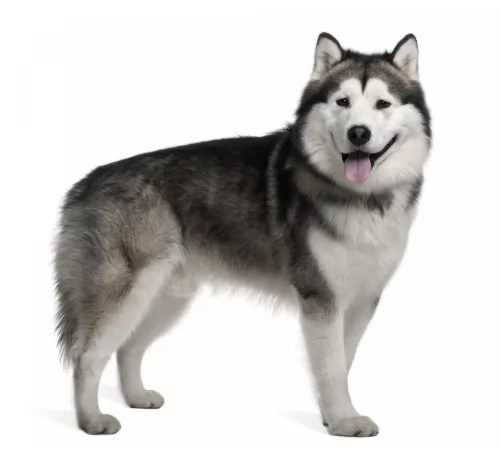 Alaskan Malamute is one of the oldest breeds. Thousands of years ago, native people in the land between Alaska and Siberia. From the beginning, this breed is used as working dogs. Alaskan Malamute was a perfect dog for seal or bear hunting, and sledding supplies back home. During the gold rush, this breed became even more popular, and that popularity only grew over the years. They have been popular even during the war years. Army used them as sled dogs in the war.
Alaskan Malamute is one of the oldest breeds. Thousands of years ago, native people in the land between Alaska and Siberia. From the beginning, this breed is used as working dogs. Alaskan Malamute was a perfect dog for seal or bear hunting, and sledding supplies back home. During the gold rush, this breed became even more popular, and that popularity only grew over the years. They have been popular even during the war years. Army used them as sled dogs in the war.
With the Mastiff breeds, the rarest and the smallest is the Nebolish Mastiff. Bred to be more agile than the giant mastiffs, the Nebolish was developed in Canada. They were developed by crossing several breeds, such as the English Mastiff, Neapolitan Mastiff, Dogue de Bordeux, Bull Terrier, Bullmastiff, Boxer, St. Bernard, and Deutsche Dogge. Perhaps there was some Great Dane as well. It was also hoped that they would have better health than the rest of the Mastiff breeds.
There are also those who believe the Nebolish Mastiff is not a Canadian crossbreed but rather the re-creation of the giant dogs that lived with the soldiers of Alexander the Great. Still others believe the breed is still being developed and no standard is yet true. They believe the dog is a hybrid. No one knows the exact breeding lines today and not many are breeding the Nebolish today. Thus, the dog is extremely rare.
Only the American Breeder Association (ABA), the Canada Molosser Association (CMA) and the Dog Registry of America Inc. (DRA) recognize the Nebolish Mastiff as a separate breed.
These dogs are courageous, loyal and dignified like all Mastiffs. They are protective of their families or their flocks. They are loving, intelligent and even-tempered. They are known to be great with kids since they are patient and calm – easy to train.
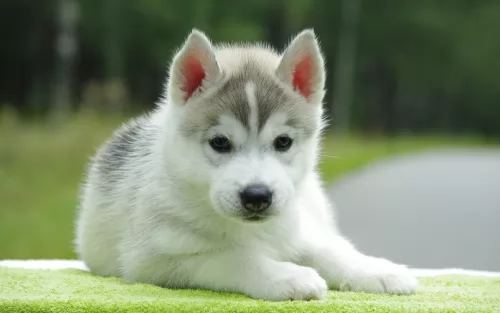 Average weight of Alaskan Malamute variates from dog to dog, but male weights 37-39kg, while female weight is 32-34kg. An average height of the male is 62-64cm, while females are slightly smaller with a height of 56-58cm.
Average weight of Alaskan Malamute variates from dog to dog, but male weights 37-39kg, while female weight is 32-34kg. An average height of the male is 62-64cm, while females are slightly smaller with a height of 56-58cm.
A lifespan of this breed is 12-15, but if your dog is healthy with the balanced diet they tend to live much longer.
Litter Size of Alaskan Malamute is 4-8 puppies, but this depends on every dog.
Other Names for Alaskan Malamute are Mal and Mally
The Nebolish Mastiff is very much like all other mastiffs with the exception of height and weight. He has a large head, long legs, strong neck, oval shaped paws, wide chest and large bones. He has solid muscles, large ears and a wide snout. They usually weigh anywhere between 43 and 82 kg. They tend not to slobber like the other mastiff breeds as a result of their breeding. They have a black mask and tail may or may not be docked.
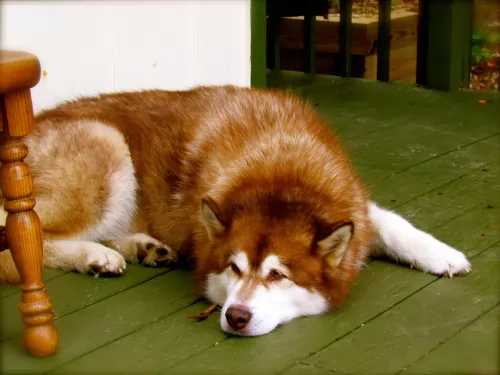 Alaskan Malamutes are playful dogs that love running, playing and spending time outside with their family. They would greet anyone who comes to your house, no matter if they are first-time visitors. That makes them bad watchdogs. Since they are a pack breed, they love spending time with humans and they love being included in activities. Generally speaking, they are great with children. They have a lot of patience for the little ones in your family. If they are socialized properly, you will not have any problems with other animals. They love playing and spending time running around, so you will not have to worry. They might run towards cats, so you have to be careful. Alaskan Malamute is not very easy to train because they are very intelligent and stubborn breed. Not very recommendable for new owners. The best way to train your puppy is with patience, consistency and positive awarding. They do not like the old-fashioned way of punishment with beating included. Instead, rather try being positive and give your dog nice treat when the task is completed.
Alaskan Malamutes are playful dogs that love running, playing and spending time outside with their family. They would greet anyone who comes to your house, no matter if they are first-time visitors. That makes them bad watchdogs. Since they are a pack breed, they love spending time with humans and they love being included in activities. Generally speaking, they are great with children. They have a lot of patience for the little ones in your family. If they are socialized properly, you will not have any problems with other animals. They love playing and spending time running around, so you will not have to worry. They might run towards cats, so you have to be careful. Alaskan Malamute is not very easy to train because they are very intelligent and stubborn breed. Not very recommendable for new owners. The best way to train your puppy is with patience, consistency and positive awarding. They do not like the old-fashioned way of punishment with beating included. Instead, rather try being positive and give your dog nice treat when the task is completed.
Yes, they are very good with children.
Agility and swimming
No – they don’t do well with apartments and small spaces. They need a large fenced in yard.
High but can be stubborn
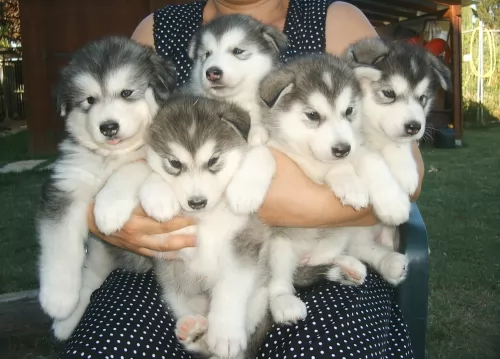 Usually Alaskan Malamute is a very healthy breed. They do not have any major issues but like every other breed, they can develop some illness. Cataracta, Chondrodysplasia, and hip dysplasia are the most common health issues, but you shouldn’t be worried because they are not happening all the time. You must talk with people who are giving you the puppy to examine the genetics. With healthy breed, and regular vet checks you will have a happy and a healthy dog for a long time.
Usually Alaskan Malamute is a very healthy breed. They do not have any major issues but like every other breed, they can develop some illness. Cataracta, Chondrodysplasia, and hip dysplasia are the most common health issues, but you shouldn’t be worried because they are not happening all the time. You must talk with people who are giving you the puppy to examine the genetics. With healthy breed, and regular vet checks you will have a happy and a healthy dog for a long time.
Bred to be much healthier than other mastiff breeds, the Nebolish has very few health concerns. They live twice as long as most other Mastiff and giant breeds at up to 14 years. The most often reported health issue is:
bloat – where the intestines and stomach organs are twisted or distended. Bloat can be deadly so don’t hesitate on treatment. Avoid it by not overfeeding after or before exercise.
Test for Hip dysplasia as it can cause lameness or arthritis.
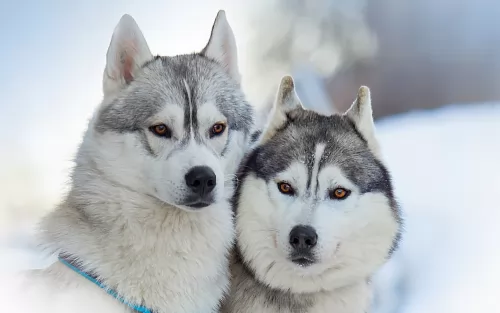 Feeding of your Alaskan Malamute depends on various things. Metabolism, size of the dog, age, quality of the food, build and activity. So you have to understand your dog's needs. Overall, 4-5 cups of high-quality dry food would be enough. Of course, you can give your dog some fruit or vegetables too, as a treat. If your dog likes to spend most of the day on the couch, you don’t have to feed it as much as people who have more active dogs.
Feeding of your Alaskan Malamute depends on various things. Metabolism, size of the dog, age, quality of the food, build and activity. So you have to understand your dog's needs. Overall, 4-5 cups of high-quality dry food would be enough. Of course, you can give your dog some fruit or vegetables too, as a treat. If your dog likes to spend most of the day on the couch, you don’t have to feed it as much as people who have more active dogs.
Developing puppies need more food than an adult dog. They should eat 3-5 times per day, of high-quality puppy food. Puppy food contains more nutrient that will help to develop your dog into a healthy adult.
Grooming Alaskan Malamute may be little challenging. They have a lot of hair, so regular brushing is a must. 2-3 times a week at least. They shed a lot 2 times a year, and you will have to use vacuum-cleaner every day.
Don’t overfeed and don’t feed too much protein in the first year. Feed 1-2 cups in two meals.
bloat – Tendency to become obese so don’t over feed. About 2-3 cups in 2 meals per day.
agility and flexibility
This intelligent breed actually enjoys training, toys and all kinds of mentally stimulating puzzles. They love water and are very good swimmers. They need an average amount of exercise - a couple walks per day. Need a large fenced yard. They make great therapy dogs and play catch.